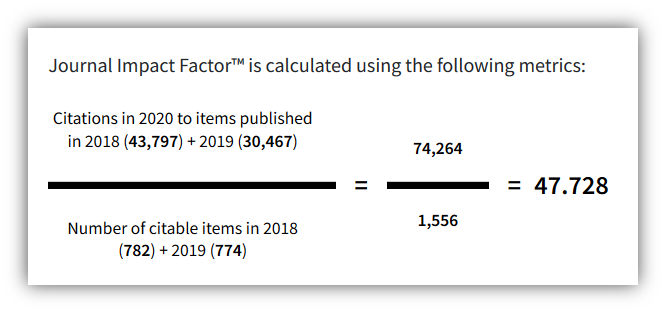Research evaluation in the Czech Republic and evaluation of authors in the global context uses various existing indicators to measure the prestige of journals, authors, author teams, institutions and the like. These indicators are calculated on the basis of the citation rate of a group of publications. The citation data are taken from specialized databases, which connect publications and their citations - i.e. citation databases such as Web of Science and Scopus. There are many types of indicators. Selected indicators which are most often used are described below.
Impact factor
Impact factor
Impact factor (IF; journal impact factor) is a bibliometric indicator evaluating journals that has been developed and used exclusively by the producers Web of Science, resp. Journal Citation Reports. It reflects the citation impact of articles published in a particular journal in the previous two years. For more information on IF visit the producer’s website.
How is Impact Factor calculated?
IF = number of citations in the current year for articles published in the previous two years divided by the number of publications in the journal in the previous two years. The example shows how IF 2020 or the Science journal has been calculated.
How does a journal obtain Impact Factor?
IF can only be calculated when the journal has been included in WoS for the entire previous two years (i.e. for the entire period for which the IF is calculated). IF is calculated once a year, always in the summer of the following year, i.e. IF 2020 was calculated and published approximately in June 2021. IF is calculated only for journals indexed in the SCIE a SSCI citation indexes.
Where can I find the list of journals with IF and its current value?
The list of journals and their IF is available in the Journal Citation Reports database in the detailed record of the required journal. The journal titles can be looked up directly by their title or by ISSN or in groups by discipline, publisher or the country of publishing. You can also find the basic IF information in any article record in Web of Science.
How can I find journals for my research?
In Journal Citation Reports, select the „Select Category“ option, select one or more subject categories according to your needs and confirm your choice by the „Submit“ button at the bottom of the page.
Hirsch index (h-index)
Hirsch index
Hirsch index (h-index) is an index reflecting the citation rate of authors or groups of authors. The H-index is the number h, which indicates the number of publications that have been cited at least h-times. It indicates the number of the most highly cited articles by a particular author regardless of the total number of the author’s publications. The h-index is calculated by both citation databases, Web of Science and Scopus, in both cases over the records stored in each database. Therefore the h-index value might differ between the two sources.
How to calculate h-index
The h-index for an author can be calculated from the citation responses of author’s published articles. The h-index is equal to the serial number of the last publication (publications are sorted in descending order by the number of citations received), which has the number of citations equal to or higher than its serial number. The H-index is the number h, which indicates the number of publications that have been cited at least h times.
To illustrate the calculation:
1. article A ... 10 citations
2. article B ... 5 citations
3. article C ... 3 citations ... h-index =3 => numerical order = number of citations
Regardless of the total number of publications, 3 publications were cited at least 3 times.
Example II.:
1. article A ... 79 citations
2. article B ... 62 citations
3. article C ... 14 citations ... h-index = 3
4. article D ... 2 citations
Regardless of the total number of publications and citations received, 3 publications were cited at least 3 times.
Similar to the Impact Factor, the Hirsch Index does not compare the performance of authors in different fields. It is discipline-specific and results are difficult to compare across disciplines. A carefully maintained personal bibliography, including citation references, is an essential prerequisite for a complete and high-quality basis for calculating the h-index. The h-index value might differ in the databases as it depends on the source of the data you work with. It depends on the group of publications that are indexed by the particular source. As a consequence Wos, Scopus or Google Scholar for example may give differnet values. You can also calculate your h-index by yourself based on the methodology described above. Before submitting your h-index value make sure which source of data is requested.
Finding your h-index in Web of Science
Web of Science calculates h-index for any set of records - e.g. search results for a specific query (author, institution, subject area, etc.). Find the h-index value from the list of searched results by clicking on the icon „Create Citation Report“ in the upper right-hand corner. This link will generate a citation report for you. The h-index value is displayed among the basic citation data.
Besides in the basic search interface in WoS, you can also find your h-index in your WoS author profile. Access your profile through klicking your name on any of your publication records or by searching your name on the authors tab. Before using your h-index value, make sure that your WoS profile is up-to-date. Take into account that there might be mistakes in the WoS profiles as it is a new feature. For details about author profiles, see this article.
In case you maintain your list of publications via Publons, you will find your WoS h-index in your Publons profile. To have your h-index accurate and up-to-date, please, remember to maintain your publications thoroughly by yourself. The list of publications in Publons updates automatically from WoS.
Finding your h-index in Scopus
Finding h-index in Scopus is very similar to the process in WoS. Scopus lists h-index for any selected group of publication records – via the „View Citation Overview“ link. The second way to obtain your Scopus h-index is through the author profile in Scopus. Please, be aware that Scopus author profile is automatically generated and might be incomplete or might contain errors.
Related articles
- Hirsch J. E. (2005): An index to quantify an individual's scientific research output. Proc. Natl. Acad. Sci. 102:16569-16572
- Batista P. D. et al. (2005): Is it possible to compare researchers with different scientific interests?
- Editorial: The Hirsch Index and measuring the quality of scientific papers. Ulster Med J 2008, 77 (1)
- The h Index for Computer Science
Article Influence Score and Eigenfactor
Article Influence Score (AIS)
AIS is based on the value of Eigenfactor score. It indicates an average number of citations per article over five years. It roughly corresponds to the five year impact factor. The difference is that within the Eigenfactor score the citations are weighted on the basis of several criteria (see below).
AIS calculation can be found on the Web of Science help page. Briefly it is a hundredth of the Eigenfactor value divided by the ratio of the number of articles in the journal to the total number of articles in WoS for the given period. Thus, the number and quality (i.e. citation rate) of articles are the main factors influencing the AIS value.
Eigenfactor
It shows the total citation rate of articles published in the previous five years in the current year. It shows the article citation rate regardless of the number of published articles. The average citation rate with respect to the number of articles in a journal is consequently expressed by the Article Influence Score.
Eigenfactor shows the percentage of success of the particular journal among all evaluted jounals in JCR. The sum of all Eigenfactor values is equal to 100.
In contrast to the impact factor Eigenfactor tries to eliminate some negatives of mere basic calculation of citations. Therefore the following criteria are reflected in Eigenfactor calculation:
- uses 5 year publication and citation window,
- excludes self-citations,
- evaluates citations according to the prestige of the journal from which the citation originates (citations from prestigious, „frequently cited“ journals are of higher importance than citations from less prestigious journals).
For further information on Eigenfactor visit Eigenfactor.org websites.
Scimago Journal Rank
Scimago Journal Rank (SJR)
Scimago Journal Rank is calculated from Scopus data. Its principle is similar to the one of AIS indicator, just it is calculated on the basis of data for the last three years. In the first phase the so-called „total prestige of the journal“ is calculated, which depends on the total number of citations (citations are weighted by the prestige of the cited source). This phase is roughly analologous to the calculation of the Eigenfactor indicator. In the second phase of the calculation, the SJR is calculated as the ratio of total journal prestige to the number of articles in the journal. A detailed description of the indicator calculation is available in this article (available via Elsevier ScienceDirect).
The principle of SJR calculation is quite similar to the one of Article Influence Score
- uses 3 year publication and citation window,
- self-citations are included into the maximum share of 33 %,
- evaluates citations according to the prestige of the journal from which the citation originates (citations from prestigious, „frequently cited“ journals are of higher importance than citations from less prestigious journals).
CiteScore
CiteScore
CiteScore is being calculated from 3-year data. Its calculation is based on the same principle as the impact factor calculation. CiteScore value is equal to the number of citations in the past three years for articles published in the previonus three years divided by the number of pubications in the journal in the previous three years. CiteScore is calculated once a year, always in the summer of the following year, i.e. CiteScore of the year 2020 was calculated and published approximately in June 2021.
CiteScore is assigned to approximatelly 42.000+ journals covered by Scopus, including peer-reviewed journals, book series, and conference proceedings in 330 disciplines.
CiteScore is accessible without a Scopus subscription via Scopus Sources page and allows anybody to verify the value of CiteScore.
To monitor the current development of the CiteScore value it is possible to use CiteScore Tracker. It allows to monitor the current value month after month in the current year.
Methodology of calculation of main indicators comparison
The article "A new approach to the metric of journals’ scientific prestige: The SJR indicator", https://doi.org/10.1016/j.joi.2010.03.002 gives a brief comparison of how most frequently used indicators - SJR, AIS and IF are calculated. The table below was taken from the article and supplemented. The supplemented and thus non original data are written in italics. The original table is available in the mentioned article as Table 1.
| SJR | AIS | IF | |
| Data source |
Scopus | Web of Science | Web of Science |
| Timespan |
3 years | 5 years | 2 years |
| Journal self-citations |
included up to a maximum rate of 33 % | excluded | included |
| Citation weighting by the prestige of the source | yes | yes | no |
| How to standardize the indicator for the number of articles in the journal | The prestige of the journal divided by the total number of articles in a journal | The prestige of the journal divided by the ratio of the total number of articles in the journal to the total number of articles in the database | The prestige of the journal (number of citations) divided by the total number of articles in the journal |
The criteria for journal indexing in WoS and Scopus
The criteria for indexing journals in WoS and Scopus are listed on the producers’ websites:
The criteria for indexing conference proceedings in WoS and Scopus
The criteria for indexing conference proceedings in WoS and Scopus are listed on the producers’ websites:
- WoS
- Scopus Note: Scopus implements the same indexing criteria for journals and conference proceedings.







